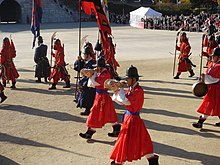This article needs additional citations for verification. (May 2009) |





A signal instrument is a musical instrument which is not only used for music as such, but also fit to give sound signals as a form of auditive communication, usually in the open air. Signal instruments are often contrasted with melodic and diatonic or chromatic instruments ("a musical (rather than signal) instrument"[1] is not uncommon phrasing). To make the message audible at a distance, percussion and brass instruments, which are generally loud, are chiefly used for this purpose. There are contemporary instruments which evolved from signal instruments, such as the natural horn evolving to the trumpet.
The oldest musical signaling instrument is the drum. Signal drums are still used in parts of Africa, although more as a kind of newspaper than military device...The African [slit] drum does not communicate by rhythm or beat, but rather by tone [relative pitch and/or timbre]...As early as 500 BCE, the Persians used kettle drums both to control cavalry formation and frighten their enemies. [In Europe,] The snare drum was the standard battlefield infantry communications device from the 1700s until well into the 1860s...Trumpets, horns, and drums were used in ancient Greek and Roman armies and navies...By the reign of Alexander the Great (336-323 BCE), trumpets and fifes...were used to control the phalanx of his army. Perhaps the earliest recorded use of specific signals via musical tones were...used by Genghis Khan's Mongol cavalry in the late twelfth and early thirteenth centuries...Trumpets (most often modified into a more compact bugle) are undoubtedly the longest-used military musical signal instrument.[2]
- ^ Fenlon, Iain; ed. (2009). Early Music History: Studies in Medieval and Early Modern Music, p.173, n.28. Cambridge University. ISBN 9780521746540.
- ^ Sterling, Christopher H.; ed. (2008). Military Communications: From Ancient Times to the 21st Century, p.307. ABC-CLIO. ISBN 9781851097326.

